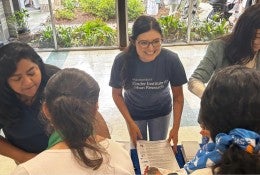In Harris County’s most food-insecure area, a nonprofit leader offers a recipe for tackling hunger
When northern Harris County residents ask Northwest Assistance Ministries for help with their basic needs, one request emerges the most: food.

In Harris County’s most food-insecure area, a nonprofit leader offers a recipe for tackling hunger
When northern Harris County residents ask Northwest Assistance Ministries for help with their basic needs, one request emerges the most: food.

Federal disaster aid is coming to Houston. Why most property owners will get left out.
Help could soon arrive for Houstonians with property damaged in last year’s two major storms — though not enough to cover even half of the still-needed repairs.

‘Clear need to ramp up’: How Houston can better prepare for the AI boom
To become an AI machine, Houston still has some learning to do.

How much is homeowners insurance in Harris County? See average rates in your neighborhood.
Homeowners across Harris County are paying significantly more in property insurance premiums than in years past, adding to the financial strain on residents struggling with housing costs.

How researching with mothers — not just about them — can produce better solutions
Houston faces significant maternal health challenges, but the best solutions often come from the people dealing with them every day.

Houston draws talent, but how can it grow more of its own?
Greater Houston’s ever-expanding economic opportunities continue to draw thousands of out-of-towners into the area — with big investments by Apple, Nvidia and Tesla still in the pipeline.

Bureaucracy, stigma keep public assistance out of reach for thousands of Houstonians
Harris County residents miss out on nearly $1 billion in unclaimed government assistance every year, according to an estimate by Connective, a Houston-based nonprofit that is trying to address the problem even as federal efforts could erode these resources.

‘Vulnerable people in vulnerable places’: How costs and climate collide in Houston’s housing system
More than half a million residents in Harris County and Houston live in neighborhoods facing a triple threat of flooding, extreme heat and poor air quality, according to a new analysis by the Center for Housing and Neighborhoods at the Kinder Institute for Urban Research.

Houston’s 15-year growth in three charts
Houston’s standing as the country’s fourth-largest city has been a constant for more than four decades.

Q&A: New Houston Housing Authority CEO Jamie Bryant seeking to fast-track affordability
About 1 in 6 Harris County residents believe the cost of housing is the biggest problem facing the area, according to the 2025 Kinder Houston Area Survey. Amid federal budget uncertainty, the new CEO of the Houston Housing Authority says local solutions and resources will matter even more.

Rice University
Kraft Hall
6100 Main Street, Suite 305
Houston, TX 77005-1892